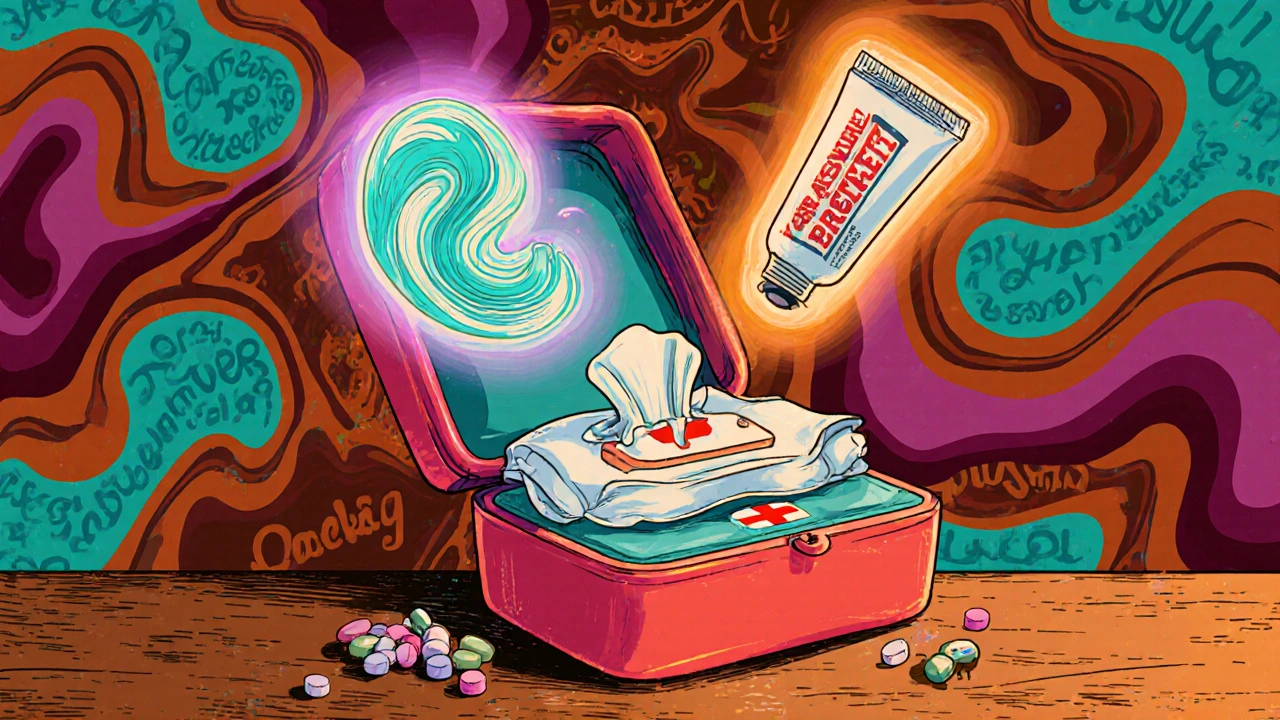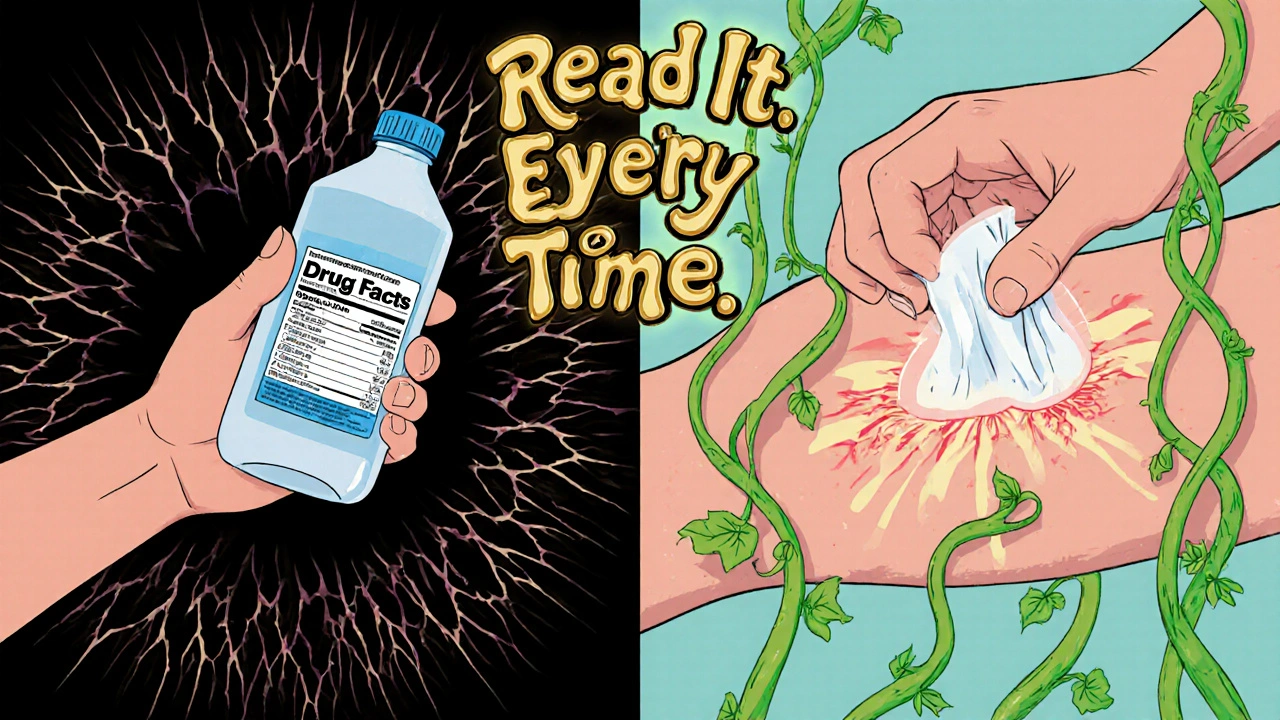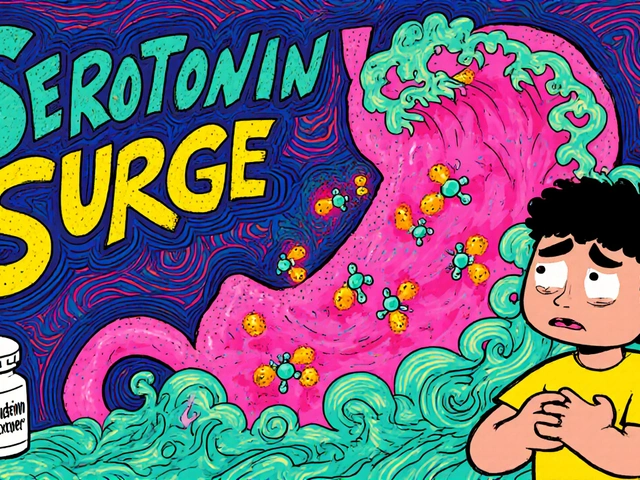
What You Need in Your First Aid Kit
Most people think a first aid kit is just a box with bandages and gauze. But if you’re serious about handling minor injuries right, you need three things: antiseptics, antibiotic ointments, and pain relief meds. These aren’t optional extras-they’re the core of any working first aid kit. Skip one, and you’re leaving yourself vulnerable to infection, slow healing, or unnecessary pain.
Antiseptics: Clean the Skin, Not the Wound
Antiseptics kill germs on the skin around a cut or scrape. But here’s the thing most people get wrong: you don’t apply them directly to an open wound. Using hydrogen peroxide or rubbing alcohol on a fresh cut doesn’t help-it hurts. It kills healthy tissue, which slows healing.
Use antiseptics on the skin around the injury. A 3% hydrogen peroxide solution or 70% isopropyl alcohol wipe works fine. But hydrogen peroxide loses its power after 30 days once opened. If your bottle’s been sitting in the bathroom since last summer, toss it. Povidone-iodine (like Betadine) is a stronger option-it kills 99.8% of bacteria in lab tests-but it stains skin and clothing. It’s great for bigger scrapes, but overkill for tiny cuts.
And don’t forget storage. Heat and light wreck these products. Keep them in a cool, dark drawer, not the medicine cabinet above the sink. Expiry dates matter. Expired antiseptics can be 40-60% less effective. Check your kit every six months. If it’s been a year since you last looked, you’re probably using junk.
Antibiotic Ointments: The Shield Between Skin and Infection
Once you’ve cleaned the area, apply a thin layer of antibiotic ointment. The gold standard is triple-antibiotic cream with bacitracin, neomycin, and polymyxin B. Brands like Neosporin dominate the market because they work. A Mayo Clinic study found they prevented infection in 92.7% of minor wounds. That’s way better than single-antibiotic options, which only hit 78%.
But here’s the catch: about 5% of people are allergic to neomycin. If your skin gets red, itchy, or swollen after using Neosporin, stop. Switch to bacitracin-only ointment. It’s less common, but just as effective for most people. And don’t overuse it. A pea-sized amount is enough for a palm-sized wound. More doesn’t mean better-it just makes a greasy mess.
These ointments don’t last forever. Once opened, they lose 15% of their strength every year. The University of Nebraska recommends replacing them every 12 months, even if they look fine. Don’t wait until the tube’s empty. If it’s been sitting since your last camping trip, it’s probably useless.

Pain Relief: Know Which One to Reach For
Not all pain meds are the same. You’ve got four main options: acetaminophen (Tylenol), ibuprofen (Advil, Motrin), aspirin, and naproxen (Aleve). Each has a different job.
Acetaminophen is your go-to for headaches, fever, or general aches. It doesn’t reduce swelling, but it’s gentle on the stomach. Great if you’re prone to ulcers or take blood thinners. But don’t go over 3,000 mg a day. Liver damage is real. One study found 68% of OTC medication errors came from people taking too much-often because they didn’t realize they were doubling up with cold meds that also contain acetaminophen.
Ibuprofen is the best for pain from inflammation-sprains, sore muscles, menstrual cramps, even post-surgery swelling. It works faster than acetaminophen for these types of pain (68% effectiveness vs. 42%). But it can irritate your stomach. If you take it daily, your risk of bleeding goes up by 1.2%. Stick to 200-400 mg per dose, max 1,200 mg a day.
Aspirin is older, but still useful. For minor pain, it’s fine. But its real superpower? Heart attacks. If someone has chest pain and you suspect a heart attack, have them chew a 325 mg aspirin. It can cut death risk by 30% if taken within 30 minutes. Keep chewable tablets in your kit. Not the regular kind-those take too long to dissolve.
Naproxen lasts longer-up to 12 hours. Good for chronic aches. But it raises blood pressure and heart risks, especially in older adults or those with existing heart issues. Avoid unless you’ve talked to a doctor.
What Experts Say About OTC Medications
Dr. Sarah Johnson from Cleveland Clinic says it simply: “Read the Drug Facts label. Never take more than directed.” That’s it. No magic. No shortcuts. 68% of mistakes come from ignoring those tiny print instructions.
Princeton University Health Services warns: “OTC meds are for minor issues only. If you need them every day, see a doctor.” That’s the line between smart self-care and hiding a bigger problem. Chronic headaches? Back pain that won’t quit? That’s not a pill problem. That’s a diagnosis problem.
The American College of Emergency Physicians says these three categories-antiseptics, antibiotic ointments, pain relievers-are non-negotiable for any home first aid kit. And they’re right. A 2021 Princeton study showed people who used proper first aid reduced complications by 35-48%. That’s not just convenience. That’s avoiding ER visits.

Storage, Expiry, and Real-World Tips
Here’s how to keep your kit actually useful:
- Check it twice a year-when you change your smoke detector batteries or when daylight saving starts/ends.
- Keep liquids away from heat. Temperatures above 86°F (30°C) for more than two weeks can knock 35% off acetaminophen’s strength.
- Use a calibrated spoon or dosing cup for liquids. Kitchen spoons are inaccurate and dangerous.
- Store tablets in a dry place. They often stay effective for years past their expiry date. But liquids? Not so much.
One Reddit user shared how keeping ibuprofen and antibiotic ointment in his work bag stopped a small cut from turning into an infection during a three-day business trip. Another admitted using hydrogen peroxide directly on a deep cut-and ended up with a 10-day delay in healing. Simple mistakes. Big consequences.
What’s Changing in OTC First Aid
Things are evolving. Johnson & Johnson just launched extended-release topical ibuprofen patches-no swallowing, just stick and go. Harvard Medical School is testing probiotic-infused antibiotic ointments to fight rising antibiotic resistance. These are promising, but they’re not replacements for the basics.
The core hasn’t changed: clean, protect, relieve. That’s still the recipe. And the FDA still requires every OTC product to have a clear Drug Facts label. That label tells you everything you need-dosage, warnings, ingredients. Read it. Every time.
Final Checklist: Build Your Kit Right
- Antiseptic: 70% isopropyl alcohol wipes or povidone-iodine (avoid hydrogen peroxide on open wounds)
- Antibiotic ointment: Triple-antibiotic (Neosporin) or bacitracin-only (for sensitive skin)
- Pain relief: Acetaminophen (Tylenol), ibuprofen (Advil), and chewable aspirin (for emergencies)
- Storage: Cool, dry, dark place. Check expiry dates every 6 months.
- Usage: Clean first, apply ointment, cover if needed. Never exceed dosage. Stop if skin reacts.
You don’t need a fancy kit. Just these three types of meds, kept fresh, used correctly. That’s all it takes to turn a small injury into a non-event.
Can I use hydrogen peroxide on an open wound?
No. Hydrogen peroxide damages healthy tissue and slows healing. Use it only on the skin around the wound, not inside it. Better options for cleaning include saline solution or gentle soap and water.
Is Neosporin the best antibiotic ointment?
It’s the most popular and effective for most people, with 92.7% infection prevention in clinical studies. But if your skin gets red or itchy after using it, you may be allergic to neomycin. Switch to a bacitracin-only ointment instead.
Which pain reliever is safest for long-term use?
None are meant for long-term daily use. If you need pain relief every day, see a doctor. Acetaminophen is gentler on the stomach than ibuprofen or naproxen, but it can harm your liver if you exceed 3,000 mg per day. Always use the lowest effective dose for the shortest time.
How often should I replace my first aid meds?
Check every 6 months. Replace antiseptics and antibiotic ointments every 12 months after opening. Pain relievers in tablet form can last 2-3 years past expiry, but liquids lose potency faster. When in doubt, throw it out.
Can I use aspirin for anything besides pain?
Yes. Chewable aspirin (325 mg) is recommended during suspected heart attack symptoms. Chewing it helps it enter your bloodstream faster, which can reduce death risk by up to 30% if taken within 30 minutes. Keep these in your kit-not regular tablets.





Sean Hwang
November 14, 2025 AT 08:09Been using isopropyl wipes for years after cuts-never touched hydrogen peroxide on an open wound. Learned that the hard way after a hiking trip gone wrong. Skin around the cut? Clean. Inside? Just rinse with water and slap on some ointment. Works every time.
Barry Sanders
November 15, 2025 AT 16:03Neosporin? Please. It's just a marketing scam. Bacitracin alone works just as well. And 92.7%? Where's the peer-reviewed study? Also, people who use expired meds deserve to get infected.
Chris Ashley
November 16, 2025 AT 16:28bro i used peroxide on a cut last year and it burned so bad i cried. now i just use soap and water. why do people still think peroxide is magic? it's not. it's just old school nonsense.
kshitij pandey
November 18, 2025 AT 02:26Love this guide! In India, many still use turmeric paste on wounds-natural, but not always sterile. Glad to see science-based advice. For pain, paracetamol is common here, same as acetaminophen. And yes, check expiry dates! My aunty still uses 5-year-old ibuprofen. 😅
Brittany C
November 18, 2025 AT 15:29The pharmacokinetics of topical antibiotic penetration are significantly compromised beyond 12 months post-opening, particularly in non-sterile environments. Additionally, the degradation kinetics of hydrogen peroxide under ambient photolytic exposure render it functionally inert. The FDA’s Drug Facts labeling framework remains the most reliable heuristic for self-administration.
Sean Evans
November 19, 2025 AT 12:01YOU’RE ALL DOING IT WRONG 😤. If you’re using Neosporin, you’re already allergic to something in it. And why the hell are you storing meds above the sink?! That’s a bacteria farm! I keep mine in a sealed Tupperware in the fridge. If you don’t, you’re a walking infection risk. 🤢
Anjan Patel
November 21, 2025 AT 00:09Let me tell you about my cousin-he used naproxen for his back pain for 6 months straight. Then he had a stroke. SIX MONTHS. And you people think OTC meds are ‘safe’? NO. THEY’RE SLOW KILLERS. STOP BEING LAZY AND SEE A DOCTOR.
Scarlett Walker
November 22, 2025 AT 17:32My mom taught me to keep chewable aspirin in the car. Said if someone ever had chest pain, don’t wait-chew it. Best advice ever. I keep one in my purse now. Small thing, big difference. ❤️
Hrudananda Rath
November 23, 2025 AT 01:28It is with profound disappointment that I observe the casual dismissal of pharmaceutical science in favor of anecdotal empiricism. The utilization of unregulated, non-standardized topical agents constitutes a gross dereliction of personal hygiene and public health responsibility. One must consult peer-reviewed literature, not Reddit.
Brian Bell
November 23, 2025 AT 11:04Y’all need to check your kits twice a year like the post says. I did it last month and found a 3-year-old tube of Neosporin that was basically oil. Tossed it. Bought new ones. Life’s too short for bad first aid. 🙌
Nathan Hsu
November 23, 2025 AT 13:41Indeed, the importance of adhering to the manufacturer's stated expiration dates cannot be overstated; however, one must also consider the environmental conditions of storage-humidity, temperature fluctuations, and light exposure all contribute to the degradation of active pharmaceutical ingredients. Furthermore, the use of calibrated dosing devices is not merely advisable-it is imperative.